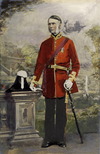MUNRO (Monro), HECTOR, mason, building contractor, and real estate agent; b. 21 Jan. 1807 in Roxburghshire (now part of Borders), Scotland; m. in March 1832 at Edinburgh, Scotland, Jane Barnet, and they had three sons and three daughters; d. 5 Oct. 1888 in Montreal, Que.
Hector Munro received his training as a mason in Scotland under his father, who was a building contractor. He and his wife left Great Britain to settle in Montreal in 1832, but there is scant information about his activities during the years following his arrival. The earliest record of Hector Munro in Montreal is a notarial contract dated 1843 concerning the building of the Commercial Bank of the Midland District; on it he is described as a master builder. The Montreal directory of 1848 lists Munro as a contractor, a sure sign that in the years since his arrival he had acquired status in the construction field. Subsequently he built or repaired numerous buildings both in Montreal and elsewhere. The Bonsecours Market, constructed in the 1840s following the plans of architect William Footner at a cost of £70,000, was his most famous undertaking. This building, which was 500 feet long, served as both market and city hall.
Munro’s principal clients were public institutions and large private companies. In the public sector he carried out a number of building contracts for the Protestant Board of School Commissioners for the City of Montreal and for Montreal itself; he also undertook canal construction for the provincial government. In the private sector his projects included participating in the construction, begun in 1854, of the section of the Grand Trunk linking Longueuil, Canada East, to the border of Canada West. Munro certainly benefited from the economic boom of the 1850s which fostered the growth of Montreal and was exemplified by the upsurge in railway construction. In 1852 he himself was one of the incorporators of companies in Canada West such as the London and Port Sarnia Railway Company, the Hamilton and Toronto Railway Company, and the Hamilton and Port Dover Railway Company.
During the 1860s Munro was more involved in real estate operations and management; thus in the Montreal directory for 1864–65 he listed himself as a “General Agent for the sale, lease and valuation of real estate, the preparation of plans, specifications and superintendence.” Moreover he offered his services as an architect in 1874–75, according to the entry in the Montreal directory. At his death in 1888, the Montreal Daily Witness described him as a property owner, although the returns in the Montreal land register for that year show he owned only the land on which his residence in Saint-Antoine Ward stood.
Munro was also active in voluntary organizations. He was one of the pioneers of the Montreal Mechanics’ Institute founded in 1840 and was its president from 1860 to 1862. In 1864 he was one of the founding members of the Seaman’s Union Bethel, of Montreal. Evidently a staunch Presbyterian he was a deacon and an elder in the St Gabriel Street Church until 1870, and was an active member of the Montreal Auxiliary Bible Society. Finally, from 1865 to 1869, he was a member of the Protestant Board of School Commissioners for the City of Montreal.
Hector Munro was a figure of some significance in Montreal. By 1840 the city, in both its architecture and its town planning, was coming under the British influence later to be termed Victorian. This influence stemmed largely from the activity of individuals such as Munro; trained in Great Britain he pursued his career in Montreal at the time when that city was experiencing unprecedented growth and development. Hector Munro was one of those who shaped the physical environment of 19th-century Montreal.
ANQ-M, État civil, Presbytériens, St Paul’s Church (Montreal), 5 Oct. 1888; Minutiers, Théodore Doucet, 28 mai 1857; William Easton, 11 April 1844, 6 Jan. 1845; J. C. Griffin, 14 July 1847; J. H. Isaacson, 12 Aug. 1858; William Ross, 15 Sept. 1843, 23 May, 10 Sept. 1844. General Register Office (Edinburgh), Register of marriages for the parish of Edinburgh, March 1832. Can., Prov. du, Statuts, 1852–53, c.44, c.101, c.102; 1864, c.152. Extracts of the books of reference of subdivisions of the city of Montreal, ed. L.-W. Sicotte (Montreal, 1874). Gazette (Montreal), 8 Oct. 1888. Montreal Daily Star, 8 Oct. 1888. Montreal Daily Witness, 6 Oct. 1888. Borthwick, Hist. and biog. gazetteer, 185. Montreal directory, 1842–68; 1874. Campbell, Hist. of Scotch Presbyterian Church, 564, 605–6. [T. M. Gordon], The Mechanics’ Institute of Montreal, founded 1840; one hundredth anniversary, 1840–1940 ([Montreal, 1940]). J.-C. Marsan, Montréal en évolution: historique du développement de l’architecture et de l’environnement montréalais (Montréal, 1974).
© 1982–2024 University of Toronto/Université Laval
Image Gallery
![Original title: Hector Munro [image fixe]](/bioimages/h100.4921.jpg)
Cite This Article
Jean-Claude Robert, “MUNRO, HECTOR,” in Dictionary of Canadian Biography, vol. 11, University of Toronto/Université Laval, 2003–, accessed April 20, 2024, http://www.biographi.ca/en/bio/munro_hector_11E.html.
The citation above shows the format for footnotes and endnotes according to the Chicago manual of style (16th edition). Information to be used in other citation formats:
| Permalink: | http://www.biographi.ca/en/bio/munro_hector_11E.html |
| Author of Article: | Jean-Claude Robert |
| Title of Article: | MUNRO, HECTOR |
| Publication Name: | Dictionary of Canadian Biography, vol. 11 |
| Publisher: | University of Toronto/Université Laval |
| Year of publication: | 1982 |
| Year of revision: | 1982 |
| Access Date: | April 20, 2024 |






![Original title: Hector Munro [image fixe]](/bioimages/w200.4921.jpg)